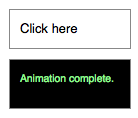返回值:jQueryfadeOut([duration], [callback])
通过改变透明度将匹配的元素淡出隐藏。
-
1.0 新增fadeOut([duration], [callback])
duration (String,Number) 可选参数,字符串("slow"或 "fast")或表示动画时长的毫秒数值。callback (Callback) 可选参数,在动画完成时执行的函数。 -
1.4.3 新增fadeOut([duration], [easing], [callback])
duration (String,Number) 可选参数,字符串("slow"或 "fast")或表示动画时长的毫秒数值。easing (String) 可选参数,要使用的缓冲效果的名称,默认值是 "swing"。jQuery 内置提供 "linear" 和 "swing" 两种效果,如果要使用更多缓冲效果,需要插件支持。callback (Callback) 可选参数,在动画完成时执行的函数。
.fadeOut() 方法对匹配元素的透明度生成动画效果。当透明度变成 0 之后,再把 display 样式属性设置成 none 以确保这个元素不再对页面布局产生影响。
duration 参数可以提供一个毫秒数,代表动画运行的时间,时间越长动画越慢。还可以提供字符串 'fast' 和 'slow' ,分别对应了 200 和 600 毫秒。如果没有设置 duration 参数,或者设置成其他无法识别的字符串,就会使用默认值 400 毫秒。
我们可以对任何元素应用动画,比如下面这个例子,对图片应用动画:
<div id="clickme"> Click here </div> <img id="book" src="book.png" alt="" width="100" height="123" />
如果元素一开始是显示的,我们可以这样将其缓慢的隐藏:
$('#clickme').click(function() {
$('#book').fadeOut('slow', function() {
// Animation complete.
});
});




注意: 为了避免不必要的 DOM 操作,
.fadeOut()不会作用于一个已经被认为是隐藏的元素。 至于哪些元素被 jQuery 认为是隐藏的,请参阅 :hidden Selector。
缓冲函数
从 jQuery 1.4.3 起,增加了一个可选的参数,用于确定使用的缓冲函数。缓冲函数确定了动画在不同位置的速度。jQuery默认只提供两个缓冲效果:swing(默认值) 和 线性缓冲效果linear。更多特效需要使用插件。可以访问 jQuery UI 网站 来获得更多信息。
回调函数
如果提供了回调函数,那么当动画结束时,会调用这个函数。通常用来按顺序执行一组不同的动画。这个函数不接受任何参数,但是 this 会设成将要执行动画的那个元素。如果对多个元素设置动画,那么要非常注意,回调函数会在每一个元素执行完动画后都执行一次,而不是这组动画整体才执行一次。
截止 jQuery 1.6,
.promise()
方法可以和
deferred.done()
方法一起使用,用于当所有匹配的元素执行完各自的动画后,再调用一个回调函数。 ( 参见 .promise() 例子 )。
补充说明:
- 所有的 jQuery 动画, 包括
.fadeOut(), 都可以被关闭,通过全局设置jQuery.fx.off = true, 效果等同于将动画时间 duration 设置成 0. 可以访问 jQuery.fx.off 来获得更多信息。 由于requestAnimationFrame()特性的原因,绝对不要在setInterval或setTimeout方法中设置动画队列。 为了保护CPU资源, 支持requestAnimationFrame的浏览器在当前窗口或标签失去焦点时,是不更新动画的。如果你通过setInterval或setTimeout方法在动画暂停时,持续向队列里添加动画,那么在窗口或标签重新获得焦点时,所有在队列中的动画都会被播放。 为了避免这个潜在的问题,可以在循环时,利用最后一个动画的回调函数,或者给元素添加.queue()方法来避免这个问题,实现动画的继续播放。
示例:
让所有段落渐渐消失,用时 600 毫秒。
<!DOCTYPE html>
<html>
<head>
<style>
p { font-size:150%; cursor:pointer; }
</style>
<script src="jquery.min.js"></script>
</head>
<body>
<p>
If you click on this paragraph
you'll see it just fade away.
</p>
<script>
$("p").click(function () {
$("p").fadeOut("slow");
});
</script>
</body>
</html>演示:
示例:
将你点击的 span 淡出隐藏。
<!DOCTYPE html>
<html>
<head>
<style>
span { cursor:pointer; }
span.hilite { background:yellow; }
div { display:inline; color:red; }
</style>
<script src="jquery.min.js"></script>
</head>
<body>
<h3>Find the modifiers - <div></div></h3>
<p>
If you <span>really</span> want to go outside
<span>in the cold</span> then make sure to wear
your <span>warm</span> jacket given to you by
your <span>favorite</span> teacher.
</p>
<script>
$("span").click(function () {
$(this).fadeOut(1000, function () {
$("div").text("'" + $(this).text() + "' has faded!");
$(this).remove();
});
});
$("span").hover(function () {
$(this).addClass("hilite");
}, function () {
$(this).removeClass("hilite");
});
</script>
</body>
</html>演示:
示例:
将两个 div 淡出隐藏。其中一个使用 "linear" 缓冲效果,另一个使用默认的 "swing," 缓冲效果。
<!DOCTYPE html>
<html>
<head>
<style>
.box,
button { float:left; margin:5px 10px 5px 0; }
.box { height:80px; width:80px; background:#090; }
#log { clear:left; }
</style>
<script src="jquery.min.js"></script>
</head>
<body>
<button id="btn1">fade out</button>
<button id="btn2">show</button>
<div id="log"></div>
<div id="box1" class="box">linear</div>
<div id="box2" class="box">swing</div>
<script>
$("#btn1").click(function() {
function complete() {
$("<div/>").text(this.id).appendTo("#log");
}
$("#box1").fadeOut(1600, "linear", complete);
$("#box2").fadeOut(1600, complete);
});
$("#btn2").click(function() {
$("div").show();
$("#log").empty();
});
</script>
</body>
</html>